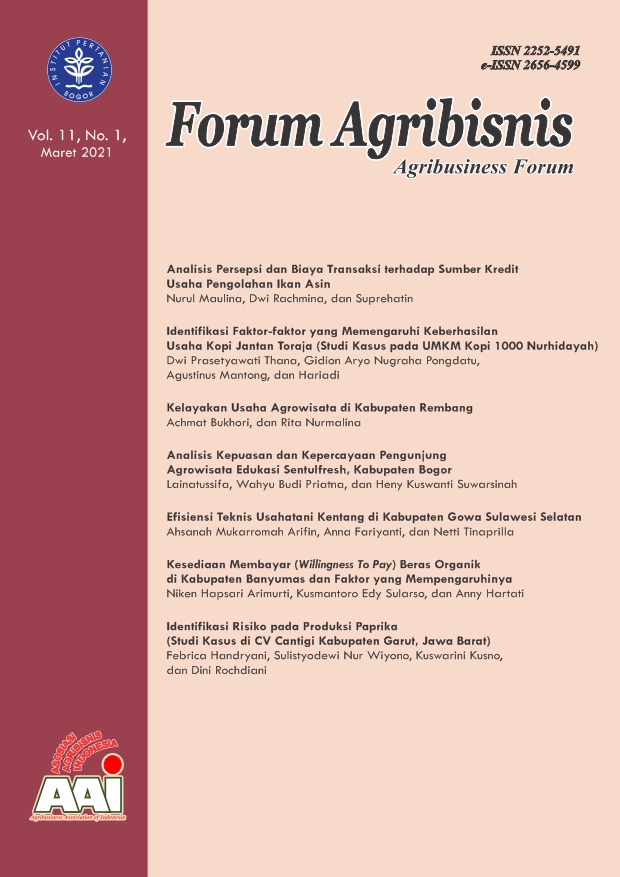Identifikasi Risiko Pada Produksi Paprika (Studi Kasus di CV Cantigi Kabupaten Garut, Jawa Barat)
Main Article Content
Abstract
Paprika is one of the leading commodities of horticulture in the provinces of West Java. West Java is the largest contributors to the national paprika in Indonesia, this leads to support the community welfare and regional development there. One of an area in West Java Province that produces paprika is CV Cantigi at Cikandang village of Garut Regency. CV Cantigi produces a variety of horticultural crops, but the main commodity is paprika. Every period CV Cantigi experienced various risk events in paprika production, thus making the productivity decrease. The purpose of this study is to identify the risks that occur in paprika production in CV Cantigi and determine the mitigation actions to minimize the risks that arise. This research uses descriptive qualitative method with the house of the risk analysis tool. The results showed that 25 risk events occurred in the process of paprika production in CV Cantigi. There are 3 mitigation actions for paprika production that is producing paprika plants under the shade because paprika plants need optimal temperatures to grow, making a planting calendar to determine when the right time to produce paprika, and making observations before pest control so that there is no wrong target with mitigation actions then it can be minimized or reducing the emergence of priority risk agents.
Downloads
Article Details

This work is licensed under a Creative Commons Attribution-ShareAlike 4.0 International License.
The author submitting the manuscript must understand and agree that the copyright of the article manuscript must be submitted/transferred to the Journal Forum Agribisnis. This work is licensed under the Creative Commons Attribution-ShareAlike 4.0 (CC BY-SA) International License in which the Author and Reader can copy and redistribute the material in any media or format, and remix, modify and build material for any purpose, but they must provide appropriate credit (citing articles or content), provide a link to the license, and indicate whether there is a change. If you mix, change, or create material, you must distribute your contribution under the same license as the original.
References
[BPS].2017. Statistik Tanaman Sayuran dan Buah-Buahan Semusim Indonesia. Badan Pusat Statistik. http://www.bps.go.id [10 Oktober 2018]
Dermawan, R. (2006). Pengambilan Keputusan Landasan Filsofis, Konsep, dan Aplikasi. Bandung: Penerbit Alfabeta.
antz, G., F. Parks, and H.C. Mellinger. 1995. Thrips Population Trends in Pepper in Southwest Florida. In B.L. Parker, M. Skinner and T. Lewis (Eds.). Thrips Biology and Management. Proceeding of a NATO Advance Research Workshop: The 1993 Int.Conf. Thysanoptera: Towards Understanding Thrips Management. Burlinton, Vermont. Sep. 28-30, 1993, NATO ASI Series. Vol. 276. Plenum Press, New York and London. p. 111-114.
Hanafi, Mamduh. 2006. Manajemen Risiko. Yogyakarta : Penerbit UPP STIM YKPN.
Hadinata, T. 2014. Standar Mutu Paprika: Potensi dan Kendala Bubidaya Tanaman Paprika di Rumah Plastik. Balitsa. Lembang-Bandung.
Harpenas, Asep & R. Dermawan. 2010. Budidaya cabai unggul. Jakarta: Penerbit Penebar Swadaya.
Heru Prihmantoro dan Y.H.Indriani. 2000. Paprika Hidroponik dan Non Hidroponik. PT. Jakarta : Penerbit Penebar Swadaya.
Kountur, R. 2008. Mudah Memahami Manajemen Risiko Perusahaan. Jakarta: Penerbit PPM.
Moekasan, T.K. L. Prabaningrum, N. Gunadi. 2008. Budidaya Paprika di Dalam Rumah Kaca Berdasarkan Konsepsi Pengendalian Hama Terpadu (PHT). Balitsa. Lembang.
Mound, L.A. 2002. So many thrips-so few tospovi-ruses. In: R Marullo and L. Mound (Eds.) Thrips and Tospovirus. Proceeding 7th International symposium on Thysanoptera. Australian National Insect Collection, Cambera, ACT. p.15-18.
Murai, T. 2002. The pest and vector from the East: Thrips palmi In: R Marullo and L. Mound (Eds.) Thrips and Tospovirus. Proceeding 7th International symposium on Thysanoptera. Australian National Insect Collection, Cambera, ACT. p. 19-32.
Prabaningrum, L., S. Sastrosiswojo, dan T.K. Moekasan. 2002. Studi Pendasaran Usahatani Paprika di Jawa Barat Sebagai Suatu Landasan Pengembangan Pengendalian Hama Terpadu. Laporan Hasil Penelitian Balitsa Tahun 2002. 11 hlm.
Pujawan, I. and Geraldin, L.H., 2009. House of risk: a model for proactive supply chain risk management. Business Process Management Journal, 15(6), pp.953-967.
Savaringga, R. 2013. Strategi pengembangan usaha cabai paprika hidroponik di koperasi petani mitra Sukamaju kecamatan Cisarua kabupaten Bandung Barat. [Skripsi]. Bogor (ID); Institut Pertanian Bogor.
Sunjaya, P.I. 1970. Dasar-dasar Ekologi Serangga. Bagian Ilmu Hama Tanaman Pertanian, Institut Pertanian Bogor. 132 hlm.

